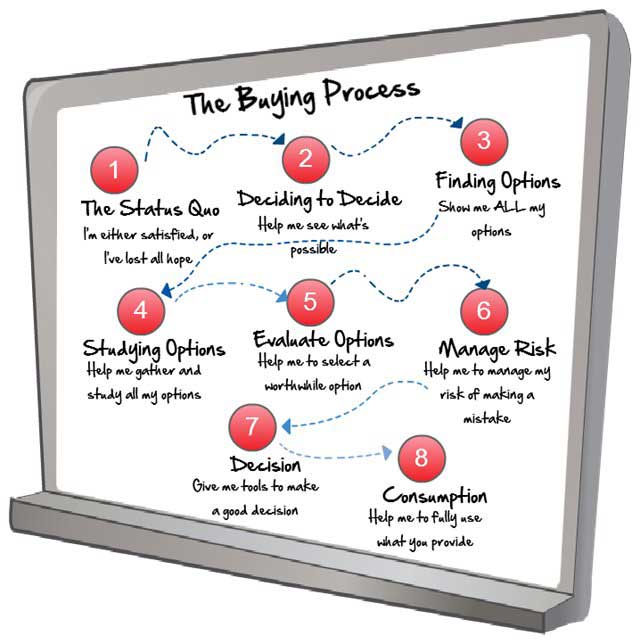A common misconception about lead nurturing in marketing automation systems is that its purpose is to "move prospects through the sales funnel.". No prospect wants to be moved anywhere. The real purpose of lead nurturing is to follow a prospect through her buying process and mirror what the prospect is thinking when she is thinking it.
Who's in charge of the buying and selling process?
Let's say you're thinking about a new surround sound system for your man or woman cave. You haven't decided to buy, but you want to explore your options.
The store salesperson does the classic solution selling routine on you. He establishes rapport, asks what you're looking for (a new surround sound system), and promptly starts selling you on a solution. Within minutes you're overwhelmed because he's talking circles around your current knowledge level.
More important, the salesperson totally missed the mark by assuming you're ready to buy. In other words, he's moving you through the sales funnel with complete disregard for your buying process.
The key problem in using marketing automation software as a sales tool is that it tries to take a shortcut through the typical sales process. The prospects download your report or whitepaper, so you naturally assume they're interested in your product. Most companies start selling solutions right out of the gate with their follow-up emails, just like our surround sound salesperson.
You know from your personal experience that this type of approach just doesn't work. Let's make things right with the following steps.
1. Follow the prospect's buying process rather than your selling process
Marketers have many buying process models. We use a model that looks like the following image:

Alternatively, sales guru Kevin Davis outlines an eight-stage model in his book Slow Down, Sell Faster!:
- Change
- Disconnect
- Research
- Comparison
- Fear
- Commitment
- Expectations
- Satisfaction
When you begin to map out your lead nurturing email campaign, keep in mind how people buy. Then, consider the kind of information, tips, advice, or knowledge you need to give them to help them remove the blocks at each stage and facilitate their movement to the next stage.
For example, if you've identified your prospect's biggest problem or worry and built your report based on that problem, you can rest assured that by downloading or viewing your masterpiece, the prospect is likely past the "Status Quo" (or "Change") and ready for the next stage.
The idea is to pay attention to where prospects are in their buying process and focus your content on facilitating their movement through each stage.
2. Focus on central cues rather than peripheral cues
The right content will educate your readers and facilitate their buying process. One of the best ways we've found to move them through the research stage, past any fears or aversions to risk, and toward a commitment, is to help them think like an expert.
This strategy involves focusing on what we call "Central Cues" rather than "Peripheral Cues":
- Central Cues are the actual feature-function-benefit of a product. An expert might be able to evaluate the relative merits based on experience, training, and education.
- Peripheral Cues are merely product attributes, such as brand, color, and display, that help people choose when they cannot easily discern the traits that make one product different from another.
In the absence of educational content, people will make decisions based on Peripheral Cues. If the products you sell are at all complex, you'll need to educate your market and facilitate comparison between your product and the alternatives to avoid buyers' making their decisions on Peripheral Cues.
But you're not simply "selling them" on the merits of your product. You have to educate your prospects about the Central Cues that enable their success.
For example, an embedded engineer tasked with adding touchscreen capabilities to a washer and dryer will be peripherally interested in processor speed, power requirements, and interface capabilities. She will be centrally interested in how easily and quickly she can move from concept to production so that she looks like a hero at work.
To truly nurture the embedded engineer and address her central concerns, you'll educate her on the issues that will help her get the hero award while peripherally providing the other details she will need to justify her "buy" decision.
3. Look past the obvious
Most salespeople are taught to "find the problem" so that they can present a solution. Unfortunately, no market has one "core problem."
In our surround sound example, the buyer was a total newbie to home entertainment systems. What about the person who's looking to upgrade his current system?
Prospects who don't download your report may still need your product, but your report may be too basic or, conversely, too filled with industry jargon to be of much use.
Rather than build a one-size-fits-all lead generation campaign, imagine that you're selling... ice cream. Try offering different flavors, with each flavor focused on a specific need, desire, interest, or preference. Yes, offering multiple options creates a certain amount of complexity in your marketing automation campaigns, but this approach is going to more closely match how your prospects think.
And, really... selling is all about aligning with what and how your prospects think. In reality, selling has nothing to do with a "sales funnel" or selling process.
Here's a final tip
You can use two approaches to ensure that you're aligned with your prospect's buying and thought processes:
- Use serial offers. Make a series of offers, including reports, white papers, webinars, and videos. Vary each set of follow-up messages to match your prospect's specific interest, segmenting your leads according to interest and position in the buying process.
- Start with one offer and branch out from there. Your initial offer shows that the prospect is interested in the general topic. Have additional offers in the queue that help you to further refine the prospect's specific interest or need and facilitate his buying process.
Either way, your primary focus is on facilitating the prospect's buying process rather than your selling process.
(For additional tips on marketing automation, download the Leader's Guide to Marketing Automation.)




